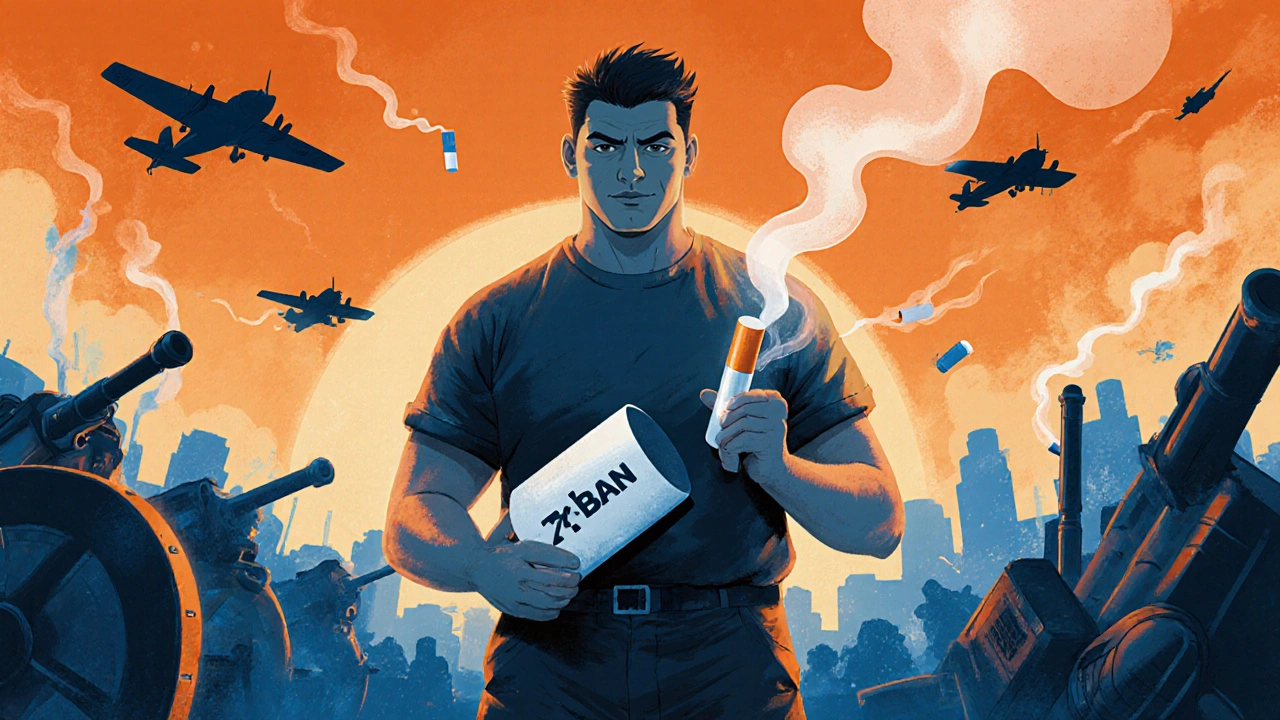Trying to quit smoking feels like a battlefield - you need the right ammo and a solid plan. Zyban (bupropion) is one of the most talked‑about weapons, but it’s not the only option. This guide breaks down Zyban side by side with the biggest alternatives, so you can pick the tool that fits your lifestyle, budget, and health profile.
What is Zyban (Bupropion) and how does it work?
Zyban is a prescription medication whose active ingredient is bupropion, an atypical antidepressant that also helps people stop smoking. The drug belongs to the class of norepinephrine‑dopamine reuptake inhibitors (NDRIs) and eases cravings by modulating brain chemicals linked to nicotine addiction.
The usual regimen starts with 150mg once daily for three days, then ramps up to 150mg twice daily for a 7‑ to 12‑week course. Clinical trials show quit rates around 25‑30% when combined with counseling, which is a noticeable bump over placebo.
Major alternatives to Zyban
When you compare Zyban to other proven methods, a few stand out:
- Nicotine Replacement Therapy (NRT) - patches, gums, lozenges, inhalers, and nasal sprays that supply low doses of nicotine without the harmful tar.
- Varenicline (brand name Chantix) - a prescription that blocks nicotine receptors, reducing pleasure from smoking.
- Cytisine - a plant‑derived partial agonist similar to varenicline, approved in several European countries and gaining U.S. interest.
- Behavioral therapy - counseling, support groups, or digital apps that address the psychological side of addiction.
How we compare the options
To make a fair match‑up, we look at four practical criteria:
- Efficacy - quit rates from randomized controlled trials.
- Convenience - dosing schedule, need for prescription, and how it fits into daily life.
- Side‑effect profile - common adverse events and any serious warnings.
- Cost - average out‑of‑pocket price in the United States.
Below is a side‑by‑side snapshot that pulls the latest data (2024‑2025 peer‑reviewed studies, FDA reports, and pharmacy price surveys).
| Product | Typical Quit Rate* | Prescription? | Common Side‑Effects | Average 12‑Week Cost (USD) |
|---|---|---|---|---|
| Zyban (Bupropion) | 25‑30% | Yes | Insomnia, dry mouth, mild tremor | $150‑$200 |
| Nicotine Patch (24‑hr) | 15‑20% | No | Skin irritation, vivid dreams | $80‑$120 |
| Varenicline (Chantix) | 30‑35% | Yes | Nausea, abnormal dreams, mood changes | $200‑$250 |
| Cytisine (Tabex) | 22‑28% | No (in many countries) | Nausea, insomnia, mild headache | $90‑$130 |
*Quit rates represent successful abstinence at 6‑month follow‑up in clinical trials.
Deep dive: Zyban vs each alternative
Zyban vs Nicotine Replacement Therapy
NRT delivers nicotine without tobacco, making cravings milder. It’s great for smokers who want a gradual taper, but it doesn’t address the brain’s dopamine surge linked to the ritual of smoking. Zyban, on the other hand, works on dopamine and norepinephrine pathways, which can curb both the physical urge and the mood swing that often triggers relapse.
In terms of convenience, NRT offers a non‑prescription route - you can buy patches or gum at any pharmacy. Zyban requires a doctor’s script, which adds a step but also provides a built‑in medical check‑up (the FDA mandates baseline blood pressure evaluation).
Side‑effect wise, NRT is usually mild (skin irritation, hiccups). Zyban’s insomnia or dry mouth can be disruptive, especially if you’re a night‑shift worker. Costwise, a 12‑week NRT course often ends up cheaper than Zyban, but you might need to combine several NRT forms, nudging the price up.
Zyban vs Varenicline
Varenicline is the most effective single‑agent prescription, with quit rates nudging 35%. Its mechanism is a partial agonist at the α4β2 nicotinic receptor - it blocks nicotine while still providing a low‑level stimulus, easing withdrawal. Zyban’s NDRI action is less targeted, which explains the slightly lower efficacy.
Both drugs need a prescription, but varenicline carries a heftier black‑box warning for neuropsychiatric events. If you have a history of depression or anxiety, Zyban may be the safer bet, although it also has a modest warning for seizure risk at high doses.
Cost comparisons show varenicline edging higher, and its dosing schedule (once daily after a titration period) is similar in convenience to Zyban’s twice‑daily pill.
Zyban vs Cytisine
Cytisine is a low‑cost, plant‑derived cousin of varenicline. Its quit rates sit a few points below Zyban’s, but the price advantage is striking - many online pharmacies list a 12‑week supply for under $100. However, cytisine isn’t FDA‑approved in the United States yet, so access is limited to clinical trials or overseas purchases.
Side‑effects overlap with varenicline (nausea, insomnia) but are generally milder. Convenience is good - the regimen is a 25‑day tapering schedule, so you finish the course faster than Zyban’s standard 12 weeks.
Zyban vs Behavioral Therapy
Behavioral support is the glue that holds any pharmacotherapy together. Studies repeatedly show that adding counseling boosts quit rates by 10‑15% across the board. Whether you pick Zyban or an NRT product, pairing it with a quit‑line, app, or group session is a no‑brainer.
Therapy alone (no meds) yields quit rates around 10‑15%, which is lower than any single medication but still valuable for those who can’t tolerate drugs.
Choosing the right tool for you
Here’s a quick decision flow you can run in your head:
- If you love a single‑pill routine and can get a prescription, start with Zyban or varenicline. Pick Zyban if you’re worried about mood changes; pick varenicline if you want the highest efficacy.
- If you prefer over‑the‑counter and want a “slow‑and‑steady” taper, NRT (patch plus gum) is a solid, low‑risk choice.
- If cost is a big factor and you can source cytisine legally, it gives decent results at a fraction of the price.
- If you have a seizure disorder, severe hypertension, or are pregnant, avoid Zyban and discuss alternatives with your clinician.
- Regardless of the drug, stack it with at least 4weeks of behavioral counseling - it’s the secret sauce for long‑term success.
Safety, side‑effects, and special populations
All smoking‑cessation aids have caveats. Below is a concise cheat‑sheet:
- Zyban: contraindicated in patients with seizure disorders or those on monoamine oxidase inhibitors (MAOIs). Warn about insomnia; taking the dose early in the day can help.
- NRT: avoid in patients with recent heart attacks unless cleared; skin irritation is common with patches.
- Varenicline: monitor for mood swings, especially in new users; pause if severe depression emerges.
- Cytisine: limited data in pregnant women - generally avoided.
- Behavioral therapy: safe for everyone, but intensity matters - weekly group meetings work better than one‑off counseling.

Real‑world stories
Mark, a 42‑year‑old accountant, tried NRT twice and kept relapsing during stressful tax season. His doctor switched him to Zyban, and with weekly tele‑counseling, Mark stayed smoke‑free for 18months. He says the “energy boost” from the dopamine effect kept his cravings at bay when the deadlines piled up.
Sarah, a 29‑year‑old teacher, couldn’t tolerate Zyban’s dry mouth, so she tried varenicline. After a week of nausea, she stopped and moved to cytisine via a clinical trial. The lower cost and short taper fit her student‑budget lifestyle, and she’s been smoke‑free for six months.
Bottom line
There’s no universal champion in smoking cessation - the best choice hinges on your health profile, budget, and willingness to engage with counseling. Zyban offers a solid middle ground: prescription‑level efficacy without the strong nicotine hit of NRT, and a milder neuropsychiatric risk than varenicline. Pair it with behavioral support, and you’ve got a proven recipe for quitting.
Frequently Asked Questions
Can I use Zyban and nicotine patches together?
Yes, doctors sometimes combine Zyban with NRT to cover both the dopamine‑related cravings and the physical nicotine withdrawal. This dual approach can boost quit rates, but it should be monitored for increased side‑effects like insomnia or dry mouth.
What’s the biggest downside of Zyban?
The most common issues are insomnia and dry mouth. For people with a seizure history, Zyban is contraindicated, so they need to look at NRT or varenicline instead.
Is cytisine legal in the United States?
As of 2025, cytisine is not FDA‑approved, so it can only be obtained through clinical trials or imported under a personal use exemption. Its status may change as more data become available.
Do I need a prescription for nicotine gum?
No prescription is required. You can buy nicotine gum over the counter in strengths of 2mg or 4mg, depending on how many cigarettes you smoked per day.
How long should I stay on Zyban?
Typical treatment lasts 7-12weeks. Some doctors recommend a short taper of a few weeks after the main course to reduce any lingering cravings.




Troy Brandt, October 6, 2025
Quitting smoking is indeed a battlefield, and Zyban offers a unique ammunition that works on the brain’s dopamine and norepinephrine pathways rather than just replacing nicotine. The guide correctly points out that Zyban’s quit rates sit around 25‑30 % when paired with counseling, which is a solid improvement over placebo. One advantage of the prescription is that it forces a medical check‑up, catching hypertension or seizure risks before they become a problem. Compared to nicotine patches, Zyban eliminates the skin irritation and vivid dreams that many patch users experience, though it does bring its own side‑effects like insomnia and dry mouth. The cost is higher than most over‑the‑counter NRT options, but many insurance plans cover a portion, making the out‑of‑pocket expense more manageable. Varenicline may boast a slightly higher quit rate, yet its black‑box warning for neuropsychiatric events makes Zyban a safer bet for patients with mood disorders. Cytisine’s low price is attractive, but the lack of FDA approval in the United States means access is limited and quality control varies. Behavioral counseling remains the glue that holds any pharmacologic approach together; studies consistently show a 10‑15 % boost in success when therapy is added. When you consider convenience, Zyban’s twice‑daily pill schedule is easy to fit into most routines, especially compared to juggling multiple NRT forms. For someone who dislikes the idea of continuously applying a patch or chewing gum, a single pill can feel less intrusive. However, patients with a history of seizures must avoid Zyban, and the risk of insomnia can be mitigated by taking the dose earlier in the day. The decision matrix should weigh efficacy, side‑effect profile, cost, and personal preference equally. In practice, many clinicians start with Zyban for patients who prefer a non‑nicotine option and have no seizure history. If the patient struggles with the dryness, a simple sugar‑free lozenge can provide relief. Ultimately, the best tool is the one the smoker is willing to use consistently, and Zyban fits nicely into that spectrum for many.
Barbra Wittman, October 12, 2025
Oh sure, because spending money on a brand‑name pill that might keep you up at night is exactly what everyone wants after a long day of work. The guide’s comparison table reads like a sales brochure, but let’s not forget that Zyban’s “boost” in quit rates comes with insomnia, dry mouth, and the occasional trembling hand – delightful party tricks, right? Meanwhile, nicotine patches quietly do their job, delivering a steady dose without turning you into a jittery mess, and they’re available over the counter. If you enjoy the thrill of a prescription, go ahead, pop the tablets, and hope you don’t start dreaming about cigarettes at 3 a.m. Varenicline may have a higher success rate, but hey, a little mood swing never hurt anyone, they say. And cytisine? It’s the budget‑friendly impostor that’s still waiting for the FDA’s thumbs‑up, so you’ll be lucky if you can even get your hands on it. The guide seems eager to push Zyban as the middle ground, yet the middle ground is often where the most boring outcomes happen. If you’re truly motivated, you’ll combine any of these with solid counseling – not just rely on a pill to do the heavy lifting. So, pick your poison, but don’t be surprised when the side‑effects feel like a second addiction.
Gena Thornton, October 19, 2025
The article does a great job laying out the pros and cons of each cessation aid without overwhelming the reader. I’d add that many insurers now cover a portion of varenicline, which can offset its higher sticker price. Also, for those worried about neuropsychiatric side‑effects, discussing a low‑dose start with a doctor can be reassuring. Remember that the success rate numbers are averages; individual response can vary widely. Pairing any medication with a structured quit‑line or app often makes the difference between a short‑term attempt and lasting abstinence.
Lynnett Winget, October 25, 2025
Great points! Adding a splash of color to the journey-think of a rainbow‑colored tracking chart to mark smoke‑free days. It turns a tedious process into a mini celebration each time you tick a box. And don’t underestimate the power of a catchy playlist to drown out cravings. Creative tricks like these can keep motivation humming along.
Amy Hamilton, October 31, 2025
When you weigh the options, remember that quitting isn’t just a physical battle; it's a philosophical shift toward self‑empowerment. Zyban offers a middle‑ground that respects both the brain chemistry and personal agency, making it a compelling choice for many. Cost should never be the sole driver-investing in health yields returns far beyond dollars saved on cigarettes. For those with a seizure history, the alternative routes become crucial, and the article wisely flags that. Ultimately, the best weapon is the one you’re willing to wield consistently, and Zyban often fits that bill. Embrace the journey as a statement of personal freedom.
Lewis Lambert, November 6, 2025
Indeed, the drama of quitting can feel like a stage production, and Zyban is the understated lead that doesn’t hog the spotlight. Its twice‑daily dosing fits neatly into a morning‑and‑evening routine, like curtain calls. Side‑effects like insomnia can be a plot twist, but timing the dose earlier can tame the night‑time drama. Combine it with a supportive cast-counselors, apps, and friends-and you have a blockbuster ending. The data backs this up, making Zyban a reliable understudy when the star, nicotine, exits.
Tamara de Vries, November 12, 2025
I think its importnt to note that Zyban can b e pricey for some ppl but its still worth it if you can handle the dry mouthe side effect. Also, dont forget to talk to your doctor about your blood preasure before starting.
Jordan Schwartz, November 18, 2025
The key takeaway is to consult a healthcare provider to ensure the medication aligns with your medical history. Monitoring blood pressure and reviewing any seizure risk is essential. Also, keep a simple diary of cravings to see patterns. Combining the pill with brief daily mindfulness can smooth out the dry‑mouth issue.
Nitin Chauhan, November 24, 2025
Nice breakdown.
Angelo Truglio, November 30, 2025
Look, you can’t just throw money at a problem and expect miracles!!! The moral of the story is that personal responsibility matters-no pill will save you if you don’t commit to the lifestyle change!!! Zyban may help, but it’s not a free pass to keep smoking on the weekends!!! Both the cost and the side‑effects demand respect; you can’t ignore the insomnia, the dry mouth, the tremor-those are warning signs!!! So, before you chase the next “miracle cure,” ask yourself if you’re ready to face the hard work. Your future self will thank you for choosing discipline over a quick fix!!!
Dawn Midnight, December 7, 2025
The comparison chart is well‑structured and clearly presents the essential data. It is important to note that the side‑effect profiles differ not only in frequency but also in severity, which can influence patient preference. For instance, the insomnia associated with Zyban can be mitigated by adjusting the dosing schedule. Moreover, the contraindications for seizure disorders are non‑negotiable and must be screened prior to prescribing. While cost is a consideration, insurance coverage often adjusts the out‑of‑pocket expense for prescription medications. Finally, integrating behavioral counseling consistently improves outcomes across all modalities.
frank hofman, December 13, 2025
Honestly, the guide is solid 👍 but let’s be real, quitting is a rollercoaster 🎢. If you’re gonna pop pills, make sure you’re not just swapping one habit for another. Also, don’t forget to celebrate each smoke‑free week – treat yourself! 🎉